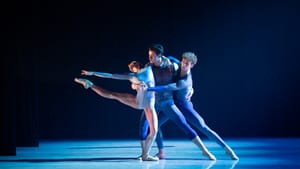Stay in the Loop
BSR publishes on a weekly schedule, with an email newsletter every Wednesday and Thursday morning. There’s no paywall, and subscribing is always free.
Dance around the world in Philly
The Pennsylvania Ballet presents ‘World Premieres’

The press release for the Pennsylvania’s Ballet’s November World Premieres performance was enticing: three electrifying new ballets by choreographers hailing from places like China and Brazil. So I was eager to see what the world of dance had to show us. Two of the pieces were lyrical marvels that did, indeed electrify the audience.
When music dominates the dance
Yin Yue may be familiar to Philadelphia audiences; she was BalletX’s first choreographic fellow in 2015. She calls her unique dance vocabulary “FoCo,” combining Chinese folk and classical dance with a Western contemporary style. Her A Trace of Inevitability opened with a series of duets that reflected that blending of styles.
Deep knees, legs so intricately entwined that my notes called them “pretzel legs,” and martial poses blended with contemporary movement that did gave it an exciting edge. Costume designer Christine Darch’s loose pants cuffed snug at the ankle in shades of oranges and reds well-suited the complex, often combative, movement. Michel Banabila’s Dragonfly II, composed for the piece, suited the early part of the dance as well, with hints of temple bells drifting through it. But the music built with such intensity and speed and volume that it overwhelmed much of the dancing in the piece’s second half. The choreography could not rise to the challenge of that insistent wave of sound, but seemed to follow a completely different, slower piece of music that we in the audience could not hear.
Pure connection
Juliano Nuñes’s Connection was gorgeous, which is not an adjective I would usually apply to a ballet danced in what appeared to be Spanx matched to the skin tone of each dancer (by costume designer Hogan McLaughlin). But the stripped-down costumes allowed us to focus entirely on the dancers themselves, and the original, but still classic, choreography. The elegant stretch of bodies felt like pure dance, a rarified embodiment of Ezio Basso’s minimalist music. In a repeating move, dancers gathered like a tight bud and spread their arms or fell to the ground like flower petals opening in the sun.
Zecheng Liang’s solo was riveting. We scarcely breathed until he stepped away, to sit and watch in elegant repose as each pair danced, and fell to the floor, and another took over the stage. Oksana Maslova, Jermel Johnson, and Arian Molina Soca flowed through a sequence of impossible combinations and lifts in a trio that seemed to fly. Among the bravura moments, something as simple as two dancers touching foreheads seemed to resonate with emotional meaning.
From time to time, the connection to the music was a bit too on-the-nose: a dance by the women had a violin accompaniment, and the parallel dance by the men was set to the lower strings, viola or cello. But I walked away wanting to see what else Nuñes can do.

My cello romance
I was predisposed to like Garrett Smith’s whimsical and dreamlike Reverberance. After all, there were cellos. But it exceeded my expectations. The performance opened with an overture of sorts: Peter Gregson, visible just off the corner of the stage, playing his “recomposition” of Bach on the cello (Gregson played the accompaniment throughout).
Then we saw the dancers, almost hidden behind cellos that rose overhead, glinting softly in the blue light, fair warning that Smith had repealed the laws of gravity for the rest of the evening. Dancers flew across the stage as if suspended in air. The grand pas de deux was spectacular: Sterling Baca tossed his partner, Nayara Lopes, in the air as if she were weightless and she spun, landed again in his arms with her legs shaping the body of a cello. The trio with Baca, Maslova, and Jack Thomas flowed like water and the dance with an actual cello tied it all together, making the music a full partner.
None of this would have worked so well without the costumes by Mónica Guerra and lighting by Michael Mazzola, which gave the performance its dreamlike quality. The dancers wore ethereal shades of blue, the men with open shirts that fluttered as they leapt across the stage, and the women in leotards of varied blues that reminded me of water. The dancers seemed to float through the misty blue light that caught glints off the suspended cellos. In Reverberance, all the parts came together to create something sublime.
Big company, small dances
I liked the dances in this triple bill, some of them very much, but I could not help thinking that the choreographers had missed a great opportunity. A contemporary troupe with ten or so dancers could have performed this program in its entirety. But the Pennsylvania Ballet is a big company, and I was surprised that no one took advantage of that to explore contemporary ideas in a big way.
What, When, Where
World Premieres. Choreography by Yin Yue, Juliano Nuñes, and Garrett Smith. The Pennsylvania Ballet. November 7 through 10, 2019 at the Merriam Theater, 250 S. Broad Street, Philadelphia. (215) 893-1999 or paballet.org.
The Merriam Theater is a wheelchair-accessible venue with an ADA-compliant restroom accessible by elevator, but the venue may pose challenges for audience members with mobility concerns. For more information about the accessibility of Kimmel campus venues, call Patron Services at (215) 893-1999 / (215) 875-7633 TTY or email [email protected].
Sign up for our newsletter
All of the week's new articles, all in one place. Sign up for the free weekly BSR newsletters, and don't miss a conversation.
 Camille Bacon-Smith
Camille Bacon-Smith